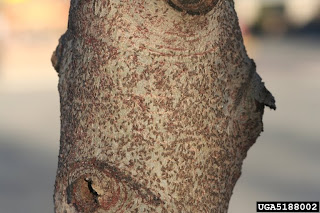
Oystershell scale infestation. Photo provided by: Whitney Cranshaw, Colorado State University, Bugwood.org
Oystershell scale nymphs (yellowish). Photo provided by: Whitney Cranshaw, Colorado State University, Bugwood.org
Tag Archives: August
Weed Hotline Issue 21

Japanese honeysuckle. Photo by: Charles T. Bryson, USDA Agricultural Research Service, Bugwood.org
Close-up of Japanese honeysuckle. Photo by: Dan Clark, USDI National Park Service, Bugwood.org
Japanese honeysuckle fruits and foliage. Photo by: Ted Bodner, Southern Weed Science Society, Bugwood.org
Trumpet creeper flowers. Photo by: Theodore Webster, USDA Agricultural Research Service, Bugwood.org
View of trumpet creeper foliage. Photo by: Dan Clark, USDI National Park Service, Bugwood.org
Trumpet creeper seeds. Photo by: Ken Chamberlain, The Ohio State University, Bugwood.org
Virginia creeper. Photo by: Theodore Webster, USDA Agricultural Research Service, Bugwood.org
Close-up of Virginia Creeper. Photo by: Ohio State Weed Lab Archive, The Ohio State University, Bugwood.org
Virginia creeper. Photo by: Ted Bodner, Southern Weed Science Society, Bugwood.org
Poison Ivy seedling. Photo by: Ohio State Weed Lab Archive, The Ohio State University, Bugwood.org
Flowering poison ivy. Photo by: Joseph LaForest, University of Georgia, Bugwood.org
Poison ivy. Photo by: Ohio State Weed Lab Archive, The Ohio State University, Bugwood.org
Poison ivy stem. Photo by: Ohio State Weed Lab Archive, The Ohio State University, Bugwood.org
Wild grape (muscardine). Photo by: Ted Bodner, Southern Weed Science Society, Bugwood.org
Close-up of wild grape (muscardine). Photo by: Ted Bodner, Southern Weed Science Society, Bugwood.org
Insect Hotline Issue 21

Bees and wasps often visit magnolia or tuliptree scales during late summer early fall to feed on the honeydew. The presence of lots of bees and wasps around magnolia or tuliptrees may indicate an infestation close-by.
The ragged hole in one of the scales on the left has been tore open and killed by a beneficial insect, probably a lady beetle.
Cluster of magnolia scale.
Sooty mold growing on honeydew that had landed on trunk and branches.
A drop of honeydew dropping from a swollen female magnolia scale. All photos were taken by: Brian Kunkel, Ornamentals IPM Specialist, University of Delaware.
Weed Hotline Issue 20

American speedwell. Photo by: Mary Ellen (Mel) Harte, , Bugwood.org
Henbit deadnettle. Photo by: Steve Dewey, Utah State University, Bugwood.org
Hairy bittercress. Photo by: Dan Tenaglia, Missouriplants.com, Bugwood.org
Henbit deadnettle seedling. Photo by: Ohio State Weed Lab Archive, The Ohio State University, Bugwood.org
Downy brome (Cheatgrass). Photo by: Leslie J. Mehrhoff, University of Connecticut, Bugwood.org
European field pansy (field violet). Photo by: Ohio State Weed Lab Archive, The Ohio State University, Bugwood.org
Purple deadnettle. Photo by: Richard Old, XID Services, Inc., Bugwood.org
Canadian horseweed. Photo by: Richard Old, XID Services, Inc., Bugwood.org
Field violet (European field pansy). Photo by: Richard Old, XID Services, Inc., Bugwood.org
Common Chickweed. Photo by: Richard Old, XID Services, Inc., Bugwood.org
Annual rygrass. Image found at http://www.agry.purdue.edu/turf/tips/2005/cale49.htm and was by Cale Bidgelow.
Disease Hotline Issue 20
Foliar nematode infesting hosta. Photo by: Bob Mulrooney, Plant Pathologist, University of Delaware
Foliar nematode infesting peony. Photo by: Bob Mulrooney, Plant Pathologist, University of Delaware
Plumbago foliar nematode. Photo by: Bob Mulrooney, Plant Pathologist, University of Delaware
Foliar nematodes infecting hosta. Photo found at:http://www.extension.umn.edu/yardandgarden/YGLNews/YGLNewsSept12007.html and taken by: Michelle Grabowski.
Sclerotium rolfsii (southern blight). Photo taken by: Nancy Gregory, University of Delaware Plant Diagnostician.
